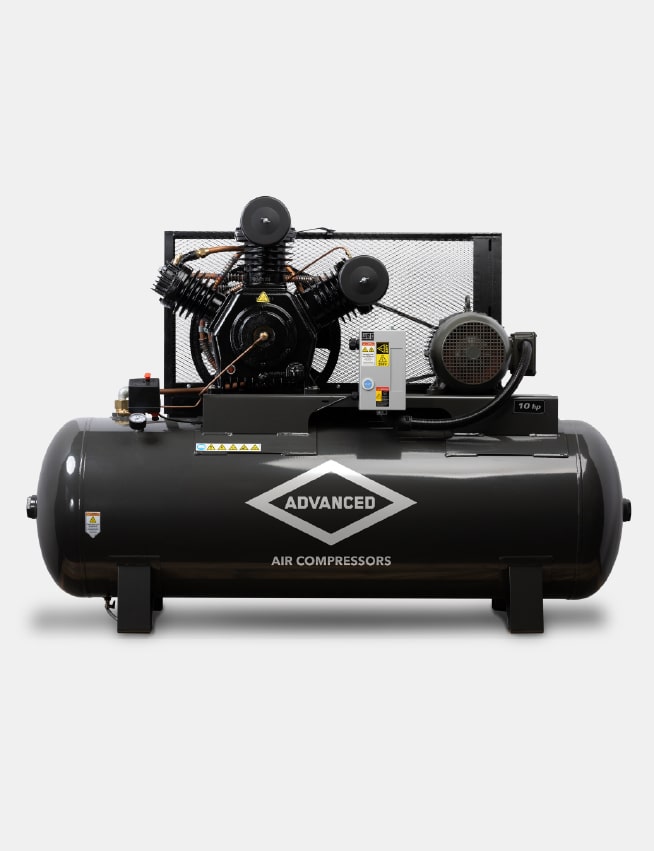When you’re searching for an air compressor, you may see a couple of different terms used to measure air flow rate, specifically CFM and SCFM. Though they’re somewhat similar, one is based on actual cubic feet at actual conditions, while the other is measured in standard cubic feet, which requires a standard condition of standard barometric pressure at a specific actual temperature and humidity. This can make a strong difference if you’re at high altitudes, have a different relative humidity, or are at a different ambient temperature.
In some situations, such as using high-demand equipment, scientific equipment, or precision equipment, these readings make a big difference in how much mass flow your air compressor receives, impacting CFM available in your pressurized air lines. In this post, we’ll get into the details of the differences between these two types of measurements, what each one will entail, and how they are calculated in case it’s important to your work.
What is SCFM?
SCFM stands for standard cubic feet per minute, a measurement of airflow at a standard temperature, standard atmospheric pressure, and standard humidity. Because these conditions are carefully controlled, they produce a very precise reading of the volumetric flow rate of an air compressor. For this reason, this calculation uses the same formula for both the American Society of Mechanical Engineers (ASME) and the Compressed Air and Gas Institute (CAGI) standards across different industries.
The requirements for SCFM rating are as follows, with usual United States units (non-SI units) listed first:
- Absolute pressure of 14.7 PSI or 1 Atmosphere
- Air temperature of 68 degrees F, or 20 degrees C
- 36% humidity
Here’s the actual (complicated) formula to calculate your standard mass flow rate:
SCFM=CFM/(Ear*(T*458.67)/Ts)
As it requires you to know the expanded air ratio (Ear) from a table, it’s probably best to use an online calculator unless you want to get really crazy with the math. Ts stands for standard temperature, or 68 degrees F.
This is especially helpful to calculate when you’re looking at compressed air systems that are basing their CFM on very different conditions than what you may be using it at. As an example, you may get a very different actual CFM if you have a high elevation with lower pressure, have very dry conditions that lower your humidity (we see you, Sonora Dessert!), or extreme temperature differences, such as Phoenix’s summer temperatures where you could fry an egg on your vehicle hood. In these situations, you may find yourself going over your duty cycle due to issues with air density,
In these conditions, knowing the SCFM allows you to calculate the kind of actual CFM that you’re likely to get out of a compressor at your location. When you have an air tool that is more dependent on the volume of air rather than the pressure per square inch, this is a very important differentiator. What are these air tools? Paint sprayers, sand blasters, powder coating guns, and similar pneumatic tools that expend air volume constantly while doing their job often require a specific volume of air flow to get the job done. If you’ve purchased an air compressor in areas with different ambient conditions than standard, you may discover that your air consumption may not keep up with your demand
However, if you use tools in a standard air-conditioned environment closer to sea level where you’ll have a higher pressure, the actual quantity of air that flows through your system will be fairly close whether you use an SCFM or CFM value, so you may not get as much difference in this type of controlled environment. If this is the case, and you’re exceeding your duty cycle because the compressor is having to work too hard to reach your working pressure, the addition of a centrifugal fan or other option to increase air flow can help increase your inlet cubic feet or inlet CFM without having to buy a new air compressor.
What is CFM?
CFM is the standard flow rate that you’ll receive in your local conditions. This is important because it can be dramatically different than SCFM based on the differences in static pressure, temperature, and humidity mentioned above, based on where your unit is tested versus your location. Being able to calculate the difference allows you to determine what kind of adaptations you’ll need to make to meet your CFM requirements at your pneumatic tools.
CFM is a measurement of inlet cubic feet per minute, or how much air density your air compressor can take in per minute, calculated using your actual temperature and actual pressure. As an example of why this is important, 1 CFM at standard conditions used at 100 PSI will equal 0.947 CFM at 3,000 feet, 0.912 CFM at 5,000 feet, 0.868 CFM at 7,500 feet, and .824 CFM at 10,000 feet of elevation, making a big difference in how much air volume your system is actually taking in to use.
This allows you to determine how much air your air compressor is taking in to determine how much it can put out to your air tools. Here’s how to calculate it:
CFM = SCFM × (14.7 psi ÷ actual pressure ) × (actual temperature + 459.67) ÷ (68°F + 459.67)
Calculating CFM is fairly straightforward as compared to calculating SCFM, so if you’d prefer to just work it out on your phone’s calculator, it’s very easy to manage. For this reason, unless you’re in extreme conditions that require you to use SCFM or you need very precise measurements, CFM will usually work fine.
Differences between SCFM and CFM
The main difference between these two systems of pressure measurement at the air compressor inlet is based on the conditions in which the measurement is taken. If you expect to be using your air compressor in an air-conditioned environment with perfect humidity at sea level with fairly stable barometric pressure, you’ll probably have very similar readings, which means that you won’t have to adapt to differences between them.
However, if you’re in very hot conditions, at a high elevation, or in very humid conditions, your CFM may be impacted from what it was originally anticipated to produce. Heat tends to make air thinner, as the molecules in the air become more excited and bounce off each other more frequently, causing them to spread out more and lower the pressure. Elevation tends to thin the air, so both of these conditions (heat and elevation) tend to lower pressure. Humidity can add a little bulk to the air, which is removed when it passes through an air dryer on the way to the lines, unless the air is dried before your system takes the air in. However, humidity’s impact tends to be lower than the other two factors.
If you’re working with very sensitive tools that have a narrow range of air flow or are in extreme environments, determining the actual CFM will give you a better idea of how those tools will perform in your environment, and will allow you to make adaptations to your system, if needed, or to select a system that will meet your needs at your conditions.
By comparison, using the SCFM that is calculated tends to work better if you’re in a more standard environment or are working with tools that have a broader range of working air flows, because a slight change in air flow at the inlet in actual cubic feet won’t impact your operation as dramatically. In these situations, SCFM and actual CFM are close enough that the difference shouldn’t impact your needs.
However, SCFM is often used extensively in scientific research, pharmaceutical production, or other high-precision needs. In these situations, setting an exact SCFM on your equipment helps to ensure that you’re getting regular, consistent results that can be reproduced exactly if needed. In these situations, the difference between CFM and SCFM can make a big difference in results, so using a standard measurement makes it easier to get the same results in each batch of work over time.
Trust the Experts of Advanced Air & Vacuum
By understanding the differences between actual CFM and SCFM, you have a better grasp of why each type of measurement is important, and how it may impact your final decision in selecting equipment for your compressed air system, as well as the final system design. You’ve also gained the knowledge to determine which type of reading should be used in which situations, making it easier to make a smarter choice when it matters most.
At Advanced Air & Vacuum, we understand the very important difference between these readings and are able to help you find the right equipment for the conditions at your specific location. That’s just one of the reasons why you’ll want to contact us for all of your air compressor, vacuum, pump, electric motor, and air compressor piping needs. Why not take a moment to contact AAV today?

